247 scholarly books by University Press of New England and 26
start with S
247 scholarly books by University Press of New England and 26
247 scholarly books by University Press of New England
26 start with S start with S
26 start with S start with S

Saber’s Edge
A Combat Medic in Ramadi, Iraq
Thomas A. Middleton
University Press of New England, 2010
The National Guardsman, the citizen soldier called upon to fight for this nation in a time of war, is one of the least understood — and perhaps one of the most compelling — figures of the Iraq War. Saber’s Edge is the story of a middle-aged Vermont firefighter called upon to be a soldier in the worst place on earth — Ramadi, Iraq. In a few short weeks Thomas A. Middleton went from being a suburban dad to a combat medic traveling between platoons, filling in for other medics and engaging in some of the fiercest and most crucial fighting of the war. This is the war as experienced from the ground level: days of tedium interspersed with the adrenalin of combat; moments of lighthearted laughter broken by the sorrow of loss. This is also the story of the unique wartime perspective of our guardsmen. Unlike the raw, unformed young recruit, the mature guardsman often comes with the burdens of family, experience, and a developed sense of self. Accordingly, Sgt. Middleton’s story chronicles the inner conflict created by his long-time professional role as a healer and his newfound life as a warrior in the urban battlefields of Iraq. Thrust into a culture and theater of war that he is little equipped or trained for, the author tries to make sense of his actions. Coarsened by combat and increasingly disdainful of the local population, he receives solace and insight from his life-long faith and ultimately emerges as a man who understands his role in the world. Saber’s Edge is also the story of the Green Mountain Boys of Task Force Saber: a story of comradeship and communion amid fierce street fighting in a crucial theater of the Iraq War (the eventual site of the “Al Anbar Awakening”). Based on the author’s first-hand experiences and interviews with other soldiers, Saber’s Edge presents a riveting account of modern urban warfare and the inspiring story of one man reconciling his actions in warfare.
[more]
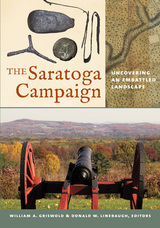
The Saratoga Campaign
Uncovering an Embattled Landscape
Edited by William A. Griswold and Donald W. Linebaugh
University Press of New England, 2016
The battles of Saratoga proved to be a turning point in the Revolutionary War when British forces under the command of General John Burgoyne surrendered to American forces led by General Horatio Gates. The Saratoga Campaign provides a new and greatly expanded understanding of the battles of Saratoga by drawing on the work of scholars in a broad range of academic disciplines. Presenting years of research by material culture scholars, archaeologists, historians, museum curators, military experts, and geophysicists, this definitive volume explores these important Revolutionary War battles and their aftermath, adding a physical and tangible dimension to the story of the Saratoga campaign. Presenting the latest hands-on research, The Saratoga Campaign is an original and multifaceted contribution to our understanding of this critical event in America’s birth.
[more]
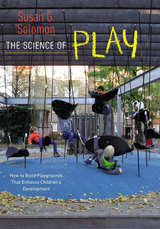
The Science of Play
How to Build Playgrounds That Enhance Children's Development
Susan G. Solomon
University Press of New England, 2014
Poor design and wasted funding characterize today’s American playgrounds. A range of factors—including a litigious culture, overzealous safety guidelines, and an ethos of risk aversion—have created uniform and unimaginative playgrounds. These spaces fail to nurture the development of children or promote playgrounds as an active component in enlivening community space. Solomon’s book demonstrates how to alter the status quo by allying data with design. Recent information from the behavioral sciences indicates that kids need to take risks; experience failure but also have a chance to succeed and master difficult tasks; learn to plan and solve problems; exercise self-control; and develop friendships. Solomon illustrates how architects and landscape architects (most of whom work in Europe and Japan) have already addressed these needs with strong, successful playground designs. These innovative spaces, many of which are more multifunctional and cost effective than traditional playgrounds, are both sustainable and welcoming. Having become vibrant hubs within their neighborhoods, these play sites are models for anyone designing or commissioning an urban area for children and their families. The Science of Play, a clarion call to use playground design to deepen the American commitment to public space, will interest architects, landscape architects, urban policy makers, city managers, local politicians, and parents.
[more]
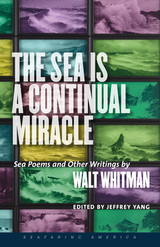
The Sea Is a Continual Miracle
Sea Poems and Other Writings by Walt Whitman
Walt Whitman
University Press of New England, 2017
From his earliest days on Long Island and in New York City to his last years in Camden, New Jersey, Walt Whitman lived close to the sea he knew and loved. The “liquid-flowing syllables” of Whitman’s poetry and prose tell specific stories of particular voyages and known shores, as well as vivid flights of imagination and keening paeans to wild winds, dark water, stormy and quiet airs. The land, for Whitman, is both immutable and still, while the sea is a realm of dynamic change, mercurial temper, and the ebb and flow of cosmic uncertainty. From “Mannahatta” to “Poem of Joys” to the magisterial ode to the slain President Lincoln, “O Captain! My Captain!” Whitman wove the strands of nautical lexicon and powerful imagery into the tapestry of our national literature. In The Sea Is a Continual Miracle, poet and editor Jeffrey Yang has compiled an invaluable resource for readers, students, and scholars of Whitman, and demonstrates how seeing him through sea glass shows America’s best-loved poet in a new light.
[more]
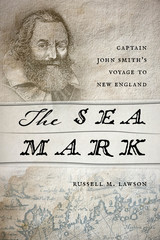
The Sea Mark
Captain John Smith’s Voyage to New England
Russell M. Lawson
University Press of New England, 2015
By age thirty-four Captain John Smith was already a well-known adventurer and explorer. He had fought as a mercenary in the religious wars of Europe and had won renown for fighting the Turks. He was most famous as the leader of the Virginia Colony at Jamestown, where he had wrangled with the powerful Powhatan and secured the help of Pocahontas. By 1614 he was seeking new adventures. He found them on the 7,000 miles of jagged coastline of what was variously called Norumbega, North Virginia, or Cannada, but which Smith named New England. This land had been previously explored by the English, but while they had made observations and maps and interacted with the native inhabitants, Smith found that “the Coast is . . . even as a Coast unknowne and undiscovered.” The maps of the region, such as they were, were inaccurate. On a long, painstaking excursion along the coast in a shallop, accompanied by sailors and the Indian guide Squanto, Smith took careful compass readings and made ocean soundings. His Description of New England, published in 1616, which included a detailed map, became the standard for many years, the one used by such subsequent voyagers as the Pilgrims when they came to Plymouth in 1620. The Sea Mark is the first narrative history of Smith’s voyage of exploration, and it recounts Smith’s last years when, desperate to return to New England to start a commercial fishery, he languished in Britain, unable to persuade his backers to exploit the bounty he had seen there.
[more]

Senator Leahy
A Life in Scenes
Philip Baruth
University Press of New England, 2017
Having vaulted to a position in the United States Senate at the tender age of thirty-four, Patrick Leahy now claims the longest tenure of any member of that institution still serving—and he was third in line for the presidency when the Democrats held control. Few recent American lawmakers have watched history unfold so at such close range; fewer still have influenced it so powerfully. Philip Baruth brings a thriller-like intensity to the most spectacular of those scenes: the 9/11 attack on the US capital, the contentious drafting of the Patriot Act, the ensuing anthrax attacks, and the dramatic 2014 opening of diplomatic ties with Cuba. Throughout, the biography focuses in on Leahy’s meticulous image making, his cultivation of a “Top Cop” persona both in the media and at the ballot box. It is an approach that culminates in simultaneous roles for the lawmaker as chair of the Senate Judiciary Committee and as the tough-talking “distinguished gentleman” in Christopher Nolan’s acclaimed Dark Knight trilogy of Batman films. Leahy’s improbable success, Philip Baruth argues, in the end lies in his ability both to be and to play the top cop not only in post-Watergate Vermont, but in a post-9/11 America viciously divided between the red states and the blue.
[more]

Sergei Prokofiev
A Biography
Robinson
University Press of New England, 2002
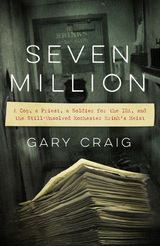
Seven Million
A Cop, a Priest, a Soldier for the IRA, and the Still-Unsolved Rochester Brink's Heist
Gary Craig
University Press of New England, 2017
On a freezing night in January 1993, masked gunmen walked through the laughably lax security at the Rochester Brink’s depot, tied up the guards, and unhurriedly made off with $7.4 million in one of the FBI’s top-five armored car heists in history. Suspicion quickly fell on a retired Rochester cop working security for Brinks at the time—as well it might. Officer Tom O’Connor had been previously suspected of everything from robbery to murder to complicity with the IRA. One ex-IRA soldier in particular was indebted to O’Connor for smuggling him and his girlfriend into the United States, and when he was caught in New York City with $2 million in cash from the Brink’s heist, prosecutors were certain they finally had enough to nail O’Connor. But they were wrong. In Seven Million, the reporter Gary Craig meticulously unwinds the long skein of leads, half-truths, false starts, and dead ends, taking us from the grim solitary pens of Northern Ireland’s Long Kesh prison to the illegal poker rooms of Manhattan to the cold lakeshore on the Canadian border where the body parts began washing up. The story is populated by a colorful cast of characters, including cops and FBI agents, prison snitches, a radical priest of the Melkite order who ran a home for troubled teenagers on the Lower East Side of Manhattan, and the IRA rebel who’d spent long years jailed in one of Northern Ireland’s most brutal prisons and who was living underground in New York posing as a comics dealer. Finally, Craig investigates the strange, sad fate of Ronnie Gibbons, a down-and-out boxer and muscle-for-hire in illegal New York City card rooms, who was in on the early planning of the heist, and who disappeared one day in 1995 after an ill-advised trip to Rochester to see some men about getting what he felt he was owed. Instead, he got was what was coming to him. Seven Million is a meticulous re-creation of a complicated heist executed by a variegated and unsavory crew, and of its many repercussions. Some of the suspects are now dead, some went to jail; none of them are talking about the robbery or what really happened to Ronnie Gibbons. And the money? Only a fraction was recovered, meaning that most of the $7 million is still out there somewhere.
[more]

Shaker Textile Arts
Beverly Gordon
University Press of New England, 1982
Today we witness a steadily growing interest in the Shakers and their way of life, especially their crafts. Although Shaker furniture, architecture, and herbs, for example, have been written about repeatedly, there are no other studies in depth of another all-important element in Shaker lives--Shaker textiles. Beverly Gordon, an experienced craftswoman and teacher, presents a comprehensive, illustrated book on the kinds of textiles the Shakers used, how they were produced, and their cultural and economic importance to the communities. She shows how Shaker beliefs were manifested in the actual artifacts and integrates detailed technical information in a way that will appeal to the nonprofessional admirers of these crafts as well as to experts. Professional dealers may use the book to verify the authenticity of a variety of items. An introductory chapter is followed by sections on the general characteristics of the textiles, their importance in Shaker lives, and the types of textile activities they undertook. Textile production, including fiber preparation, spinning, weaving, dyeing, knitting, crocheting, and sewing, is examined. Detailed descriptions of rugs and floor coverings, chair and seat tapes and cushions, clothing and personal accessories, popular cloth, and fancywork are followed by appendices on original Shaker weaving drafts, analyses of rugs and chair seat tapes, dye recipes, and instructions for knitting and constructing “fancy” items. This indispensable reference work results in part from the author’s close association with Shaker textiles between 1973 and 1977, when she was a textile interpreter at Hancock Shaker Village. Since then she has had access to artifacts and original manuscripts and documents throughout the country, works that are reflected in her full bibliography. A study from the procurement and processing of materials to the uses of finished products, this is a book of lasting value to collectors and antique dealers, museum curators, home economists, historians, weavers, and fiber artists with related specialties.
[more]
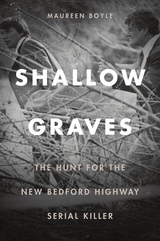
Shallow Graves
The Hunt for the New Bedford Highway Serial Killer
Maureen Boyle
University Press of New England, 2017
Eleven women went missing over the spring and summer of 1988 in New Bedford, Massachusetts, an old fishing port known as the Whaling City, where Moby Dick, Frederick Douglass, textile mills, and heroin-dealing represent just a few of the many threads in the community’s diverse fabric. In Shallow Graves, investigative reporter Maureen Boyle tells the story of a case that has haunted New England for thirty years. The Crimes: The skeletal remains of nine of the women, aged nineteen to thirty-six, were discovered near highways around New Bedford. Some had clearly been strangled, others were so badly decomposed that police were left to guess how they had died. The Victims: All the missing women had led troubled lives of drug addiction, prostitution, and domestic violence, including Nancy Paiva, whose sister was a hard-working employee of the City of New Bedford, and Debra Greenlaw DeMello, who came from a solidly middle-class family but fell into drugs and abusive relationships. In a bizarre twist, Paiva’s clothes were found near DeMello’s body. The Investigators: Massachusetts state troopers Maryann Dill and Jose Gonsalves were the two constants in a complex cast of city, county, and state cops and prosecutors. They knew the victims, the suspects, and the drug-and-crime-riddled streets of New Bedford. They were present at the beginning of the case and they stayed to the bitter end. The Suspects: Kenneth Ponte, a New Bedford attorney and deputy sheriff with an appetite for drugs and prostitutes, landed in the investigative crosshairs from the start. He was indicted by a grand jury in the murder of one of the victims, but those charges were later dropped. Anthony DeGrazia was a loner who appeared to fit the classic serial-killer profile: horrific childhood abuse, charming, charismatic, but prone to bursts of violence. He hunted prostitutes in the city by night and served at a Catholic church by day. Which of these two was the real killer? Or was it someone else entirely? Maureen Boyle first broke the story in 1988 and stayed with it for decades. In Shallow Graves she spins a riveting narrative about the crimes, the victims, the hunt for the killers, and the search for justice, all played out against the backdrop of an increasingly impoverished community beset by drugs and crime. Drawing on more than one hundred interviews, along with police reports, first-person accounts, and field reporting both during the killings and more recently, Shallow Graves brings the reader behind the scenes of the investigation, onto the streets of the city, and into the homes of the families still hoping for answers.
[more]
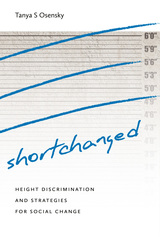
Shortchanged
Height Discrimination and Strategies for Social Change
Tanya S Osensky
University Press of New England, 2017
Would you like to be taller? Many people—except very tall people—would likely answer yes. Why should this be the case, when height has nothing to do with intelligence, talent, fortitude, compassion, or indeed any of the factors that make us human? In her thoughtful and provocative book, Tanya S Osensky examines “heightism”: the widely held and mostly unconscious notion that taller is better. She explores how and why short people are considered by many to be inferior, and describes the ways in which height bias affects them. Prejudice against short people is so common and casual that we do not even notice it, yet it factors significantly into discrimination in the workplace, in social situations, and beyond. The most helpless victims are short children, who are frequently subjected to years of hormone therapy, even when they have no physical need for such treatment, simply in an effort to make them taller as a way of countering this social bias. There is little legal recourse for short people who suffer workplace discrimination based on height. This succinct book exposes the cultural, medical, and occupational issues that short people face, which are often deemed unimportant and disregarded. Osensky challenges heightism by disclosing some beneficial aspects of shortness and suggesting avenues of activism and change.
[more]

Social Enterprise
A Global Comparison
Edited by Janelle A. Kerlin
University Press of New England, 2009
Social enterprise—the use of market-based, civil society approaches to address social issues—has been a growing phenomenon for over twenty years. Gathering essays by researchers and practitioners from around the globe, this volume examines, from a local perspective, the diverse ways in which social enterprise has emerged in different regions. Each chapter examines the conceptualization, history, legal and political frameworks, supporting institutions, and latest developments and challenges for social enterprise in a given region or country. In the final chapter, Janelle A. Kerlin presents a comparative analysis of the various models and contexts for social enterprise, showing how particular strengths in each environment lead to different enterprise initiative models.
[more]
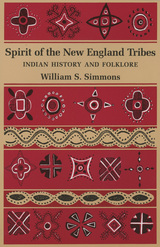
Spirit of the New England Tribes
Indian History and Folklore, 1620–1984
William S. Simmons
University Press of New England, 1986
Spanning three centuries, this collection traces the historical evolution of legends, folktales, and traditions of four major native American groups from their earliest encounters with European settlers to the present. The book is based on some 240 folklore texts gathered from early colonial writings, newspapers, magazines, diaries, local histories, anthropology and folklore publications, a variety of unpublished manuscript sources, and field research with living Indians.
[more]

Squid Empire
The Rise and Fall of the Cephalopods
Danna Staaf
University Press of New England, 2017
Before there were mammals on land, there were dinosaurs. And before there were fish in the sea, there were cephalopods—the ancestors of modern squid and Earth’s first truly substantial animals. Cephalopods became the first creatures to rise from the seafloor, essentially inventing the act of swimming. With dozens of tentacles and formidable shells, they presided over an undersea empire for millions of years. But when fish evolved jaws, the ocean’s former top predator became its most delicious snack. Cephalopods had to step up their game. Many species streamlined their shells and added defensive spines, but these enhancements only provided a brief advantage. Some cephalopods then abandoned the shell entirely, which opened the gates to a flood of evolutionary innovations: masterful camouflage, fin-supplemented jet propulsion, perhaps even dolphin-like intelligence. Squid Empire is an epic adventure spanning hundreds of millions of years, from the marine life of the primordial ocean to the calamari on tonight’s menu. Anyone who enjoys the undersea world—along with all those obsessed with things prehistoric—will be interested in the sometimes enormous, often bizarre creatures that ruled the seas long before the first dinosaurs.
[more]

States at War, Volume 1
A Reference Guide for Connecticut, Maine, Massachusetts, New Hampshire, Rhode Island, and Vermont in the Civil War
Edited by Richard F. Miller
University Press of New England, 2013
While many Civil War reference books exist, there is no single compendium that contains important details about the combatant states (and territories) that Civil War researchers can readily access for their work. People looking for information about the organization, activities, economies, demographics, and prominent personalities of Civil War states and state governments must assemble data from a variety of sources, and many key sources remain unavailable online. This volume, the first of six, provides a crucial reference book for Civil War scholars and historians, professional or amateur, seeking information about individual states or groups of states. Its principal sources include the Official Records, state adjutant-general reports, legislative journals, state and federal legislation, federal and state executive speeches and proclamations, and the general and special orders issued by the military authorities of both governments. Designed and organized for easy use, this book can be read in two ways: by individual state, with each chapter offering a stand-alone skeletal history of an individual state’s war years, or across states, comparing reactions to the same event or solutions to the same problems.
[more]

States at War, Volume 2
A Reference Guide for New York in the Civil War
Edited by Richard F. Miller
University Press of New England, 2014
While many Civil War reference books exist, there is no single compendium that contains important details about the combatant states (and territories) that Civil War researchers can readily access for their work. People looking for information about the organizations, activities, economies, demographics, and prominent personalities of Civil War states and state governments must assemble data from a variety of sources, with many key sources remaining unavailable online. This volume provides a crucial reference book for Civil War scholars and historians, professional or amateur, seeking information about New York during the war. Its principal sources include the Official Records, state adjutant general reports, legislative journals, state and federal legislation, executive speeches and proclamations on the federal and state levels, and the general and special orders issued by the military authorities of both governments, North and South. Designed and organized for easy use, this book can be read in two ways: by individual state, with each chapter offering a stand-alone history of an individual state’s war years; or across states, comparing reactions to the same event or solutions to the same problems.
[more]

States at War, Volume 3
A Reference Guide for Pennsylvania in the Civil War
Edited by Richard F. Miller
University Press of New England, 2014
While many Civil War reference books exist, there is no single compendium that contains important details about the combatant states (and territories) that Civil War researchers can readily access for their work. People looking for information about the organizations, activities, economies, demographics, and prominent personalities of Civil War states and state governments must assemble data from a variety of sources, with many key sources remaining unavailable online. This volume provides a crucial reference book for Civil War scholars and historians, professional or amateur, seeking information about Pennsylvania during the war. Its principal sources include the Official Records, state adjutant general reports, legislative journals, state and federal legislation, executive speeches and proclamations on the federal and state levels, and the general and special orders issued by the military authorities of both governments, North and South. Designed and organized for easy use, this book can be read in two ways: by individual state, with each chapter offering a stand-alone history of an individual state’s war years; or across states, comparing reactions to the same event or solutions to the same problems.
[more]

States at War, Volume 4
A Reference Guide for Delaware, Maryland, and New Jersey in the Civil War
Edited by Richard F. Miller
University Press of New England, 2015
While many Civil War reference books exist, there is no single compendium that contains important details about the combatant states (and territories) that Civil War researchers can readily access for their work. People looking for information about the organizations, activities, economies, demographics, and prominent personalities of Civil War States and state governments must assemble data from a variety of sources, with many key sources remaining unavailable online. This crucial reference book, the fourth in the States at War series, provides vital information on the organization, activities, economies, demographics, and prominent personalities of Delaware, Maryland, and New Jersey during the Civil War. Its principal sources include the Official Records, state adjutant-general reports, legislative journals, state and federal legislation, federal and state executive speeches and proclamations, and the general and special orders issued by the military authorities of both governments, North and South. Designed and organized for easy use by professional historians and amateurs, this book can be read in two ways: by individual state, with each chapter offering a stand-alone history of an individual state’s war years; or across states, comparing reactions to the same event or solutions to the same problems.
[more]

States at War, Volume 5
A Reference Guide for Ohio in the Civil War
Edited by Richard F. Miller
University Press of New England, 2015
While many Civil War reference books exist, there is no single compendium that contains important details about the combatant states (and territories) that Civil War researchers can readily access for their work. People looking for information about the organizations, activities, economies, demographics, and prominent personalities of Civil War States and state governments must assemble data from a variety of sources, with many key sources remaining unavailable online. This crucial reference book, the fifth in the States at War series, provides vital information on the organization, activities, economies, demographics, and prominent personalities of Ohio during the Civil War. Its principal sources include the Official Records, state adjutant-general reports, legislative journals, state and federal legislation, federal and state executive speeches and proclamations, and the general and special orders issued by the military authorities of both governments, North and South. Designed and organized for easy use by professional historians and amateurs, this book can be read in two ways: by individual state, with each chapter offering a stand-alone history of an individual state’s war years; or across states, comparing reactions to the same event or solutions to the same problems.
[more]
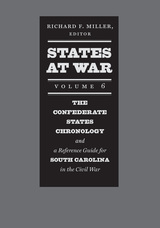
States at War, Volume 6
The Confederate States Chronology and a Reference Guide for South Carolina in the Civil War
Edited by Richard F. Miller
University Press of New England, 2018
Although many Civil War reference books exist, Civil War researchers have until now had no single compendium to consult on important details about the combatant states (and territories). This crucial reference work, the sixth in the States at War series, provides vital information on the organization, activities, economies, demographics, and laws of Civil War South Carolina. This volume also includes the Confederate States Chronology. Miller enlists multiple sources, including the statutes, Journals of Congress, departmental reports, general orders from Richmond and state legislatures, and others, to illustrate the rise and fall of the Confederacy. In chronological order, he presents the national laws intended to harness its manpower and resources for war, the harsh realities of foreign diplomacy, the blockade, and the costs of states’ rights governance, along with mounting dissent; the effects of massive debt financing, inflation, and loss of credit; and a growing raggedness within the ranks of its army. The chronology provides a factual framework for one of history’s greatest ironies: in the end, the war to preserve slavery could not be won while 35 percent of the population was enslaved.
[more]
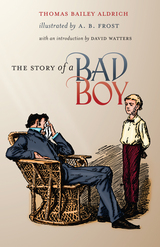
The Story of a Bad Boy
Thomas Bailey Aldrich
University Press of New England, 1996
In 1869 Thomas Bailey Aldrich introduced to American literature the original “bad boy”--that all-American boy who plays harmless pranks, devises exciting adventures, has an occasional bout of love-sickness, is bored on Sundays, and is well-liked by almost everyone. Later followed by Mark Twain’s The Adventures of Tom Sawyer and The Adventures of Huckleberry Finn, The Story of a Bad Boy--once called the first truly American novel--is Aldrich’s partially autobiographical tale of growing up in America. Set in Rivermouth (based on Aldrich’s childhood home in Portsmouth, New Hampshire), it follows the exploits of young Tom Bailey through snowball wars, schoolyard fights, Fourth of July parades, adventures at sea, and childhood sweathearts. Now printed in more than fifty editions and read and beloved by Americans for over a century, Aldrich’s classic is ready to be rediscovered by a new generation of readers.
[more]
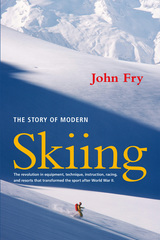
The Story of Modern Skiing
John Fry
University Press of New England, 2010
This is the definitive history of the sport that has exhilarated and infatuated about 30 million Americans and Canadians over the course of the last fifty years. Consummate insider John Fry chronicles the rise of a ski culture and every aspect of the sport’s development, including the emergence of the mega-resort and advances in equipment, technique, instruction, and competition. The Story of Modern Skiing is laced with revelations from the author’s personal relationships with skiing greats such as triple Olympic gold medalists Toni Sailer and Jean-Claude Killy, double gold medalist and environmental champion Andrea Mead Lawrence, first women’s World Cup winner Nancy Greene, World Alpine champion Billy Kidd, Sarajevo gold and silver medalists Phil and Steve Mahre, and industry pioneers such as Vail founder Pete Seibert, metal ski designer Howard Head, and plastic boot inventor Bob Lange. Fry writes authoritatively of alpine skiing in North America and Europe, of Nordic skiing, and of newer variations in the sport: freestyle skiing, snowboarding, and extreme skiing. He looks closely at skiing’s relationship to the environment, its portrayal in the media, and its response to social and economic change. Maps locating major resorts, records of ski champions, and a timeline, bibliography, glossary, and index of names and places make this the definitive work on modern skiing. Skiers of all ages and abilities will revel in this lively tale of their sport’s heritage.
[more]
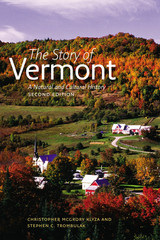
The Story of Vermont
A Natural and Cultural History, Second Edition
Christopher McGrory Klyza and Stephen C. Trombulak
University Press of New England, 2015
In this second edition of their classic text, Klyza and Trombulak use the lens of interconnectedness to examine the geological, ecological, and cultural forces that came together to produce contemporary Vermont. They assess the changing landscape and its inhabitants from its pre-human evolution up to the present, with special focus on forests, open terrestrial habitats, and the aquatic environment. This edition features a new chapter covering from 1995 to 2013 and a thoroughly revised chapter on the futures of Vermont, which include discussions of Tropical Storm Irene, climate change, eco-regional planning, and the resurgence of interest in local food and energy production. Integrating key themes of ecological change into a historical narrative, this book imparts specific information about Vermont, speculates on its future, and fosters an appreciation of the complex synergy of forces that shaped this region. This volume will interest scholars, students, and Vermonters intrigued by the state’s long-term natural and human history.
[more]

The Strange Death of Mistress Coffin
Robert J. Begiebing
University Press of New England, 2012
New England. 1648. The Piscataqua Settlement. A young woman has been found dead, her violated body stripped naked and thrown in a river. Her husband, a reclusive and learned man, has mysteriously halted his legal proceedings against the most likely suspect, who has disappeared into the wilderness. The settlement’s elders call on a young Englishman, Richard Browne, to discover the truth about what happened. But the more he learns, the more puzzling the crime becomes, and the more he finds himself drawn to the wife of the missing suspect.
[more]

Summer Light
Roxana Robinson
University Press of New England, 1995
Roxana Robinson's great gift for the telling detail and strong sense of the emotional shoals lurking just beneath even the calmest surface have inspired comparisons to literary greats like John Cheever, Henry James, and Edith Wharton. In her first novel, we meet Laura, a 29-year-old wife, mother, sister, friend, lover, and erstwhile photographer whose life is painfully out of focus. A month's vacation on the Maine coast with her son, her lover, Ward, and her sister's family is supposed to be an idyllic period of sustenance and calm, but for Laura, who believes that "entropy governed the world, the universe, and the dinner hour," it turns into the ultimate test of her ability to trust herself and others. With trademark intensity and a deft touch for character and place, Robinson creates a perceptive, believable, and gently humorous portrait of an individual "waiting for something that would set her life in order." Laura is as much a study of light and shadow as the photographs she takes. Beautiful but insecure, talented but unwilling to take risks, loved but unable to make a commitment, she is paralyzed by fear and locked into a stasis that Ward is no longer willing to accept. "You don't dare take a stand on anything," he tells her. “You're so terrified of failure you don't dare do anything.” When her estranged husband arrives for a weekend visit, however, the emotional collision rocks Laura's inaction, causing a tiny shake of the kaleidoscope that creates a vastly different pattern. The image is razor sharp at last: "As though she were changing lenses, as though she had suddenly discovered another light source," she sees that her life is her own. That new understanding empowers her to make a symbolic -- and a literal -- leap of faith that saves her own life and the lives of those she loves.
[more]

Surviving the Essex
The Afterlife of America's Most Storied Shipwreck
David O. Dowling
University Press of New England, 2016
Surviving the “Essex” tells the captivating story of a ship’s crew battered by whale attack, broken by four months at sea, and forced—out of necessity—to make meals of their fellow survivors. Exploring the Rashomon-like Essex accounts that complicate and even contradict first mate Owen Chase’s narrative, David O. Dowling examines the vital role of viewpoint in shaping how an event is remembered and delves into the ordeal’s submerged history—the survivors’ lives, ambitions, and motives, their pivotal actions during the desperate moments of the wreck itself, and their will to reconcile those actions in the short- and long-term aftermath of this storied event. Mother of all whale tales, Surviving the “Essex” acts as a sequel to Nathaniel Philbrick’s In the Heart of the Sea, while probing deeper into the nature of trauma and survival accounts, an extreme form of notoriety, and the impact that the story had on Herman Melville and the writing of Moby-Dick.
[more]
READERS
Browse our collection.
PUBLISHERS
See BiblioVault's publisher services.
STUDENT SERVICES
Files for college accessibility offices.
UChicago Accessibility Resources
home | accessibility | search | about | contact us
BiblioVault ® 2001 - 2024
The University of Chicago Press









